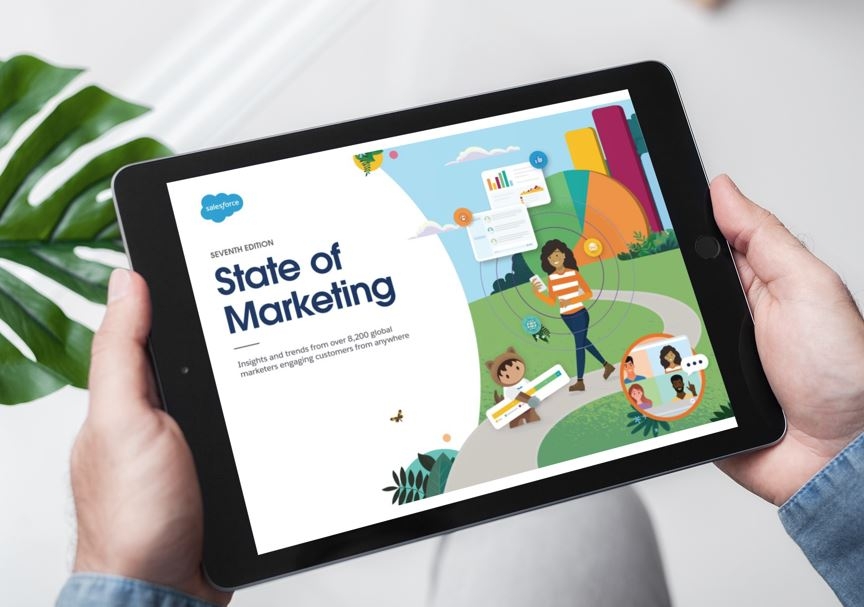Meeting buyer expectations is simultaneously becoming one of the most critical and complicated responsibilities of marketers due to the Covid-19 pandemic and rapid shift to digital, new research shows. Salesforce’s Seventh Edition of the State of Marketing report revealed that 90% of marketers evolved their digital marketing strategies to better meet buyers’ expectations over the past year.
The report found that marketers adapted their content for optimal buyer engagement in digital and social channels, with 48% completely changing their content strategies with new formats in 2021. In addition, the research showed a major shift in data management, with 47% overhauling their data strategies to account for their increased digital presence.
“The 90% breaks down into 50% completely changing their strategy and 40% somewhat changing,” said Chris Jacob, Senior Director of Product Marketing at Salesforce, in an interview with Demand Gen Report. “This means half of all B2B brands globally completely changed their digital marketing strategy in the last year. The optimism that the B2B marketers have for revenue growth ahead is a result of broad-based rapid transformation.”
To further accommodate their buyers in digital channels, marketers are prioritizing new KPIs and tools to strengthen their marketing programs and buyer engagement strategies. Additionally, they are relying on new buyer data sources to create personalized experiences for buyers in their preferred digital/social channels.
Overhauling KPIs For Stronger Buyer Insights & Internal Alignment
The accelerated shift to digital highlighted the impact of buyer data on marketing strategies, as many marketers committed to building and maintaining the quality of their databases. However, as new digital strategies and channels emerged, 78% marketers have started investing in new KPIs to measure their revenue and funnel performance in response to the pandemic.
Of these new KPIs, the three highest grossing metrics marketers tracked in 2021 include customer referral rates, customer acquisition costs and content engagement. These KPIs allowed marketers to better measure their digital marketing programs’ performance and improve their data quality for building future campaigns and outreach.
“When you see customer acquisition costs and referral rates, what you are likely seeing is a further manifestation of the larger (and rapid) digital transformation,” said Jacob. “B2B brands are finding new and more efficient ways to reach their buyers, and also identifying the right KPIs to further grow their businesses.”
Interestingly, 70% of marketers made an active effort to align their KPIs with their CEO’s. This enables fluid information sharing between CMOs, marketing teams and CEOs, helping the organization as a whole become more strategic with their data and glean new insights into buyer and channel engagement.
“Despite the rapid change in the way marketing leaders value their programs in a short time, alignment with the CEO is still strong,” Jacob explained. “This has helped teams better understand and sift through their data and serve more relevant and personalized content experiences as a unified organization in the digital channels that matter most.”
Managing New Data Sources For Greater Engagement
Another major takeaway from the research was the persisting impact of customer data on marketing. With Google pulling its support for third-party cookies, B2B marketers have started looking for new data sources to fill in the gaps in their account data.
The research cited that 78% of marketers are running data-driven engagement strategies and building content and ads based on buyer data gathered from multiple sources. The number of data sources marketers are dipping into has increased by 50% since 2020 and will continue to grow into 2022 as they proceed to analyze digital identities, second-party data and declared interests.
To manage all this buyer data, organizations have turned to customer data platforms (CDP) to help orchestrate their data management strategies. Roughly 78% of high-performing B2B organizations adopted a CDP to help their marketing team manage their buyer data, which provided the information needed to build more personalized buyer experiences quickly and efficiently.
“If managed properly, more data sources, such as known digital identities, transaction data and customer service data, can provide a richer view of a buyer or account to inform strategy and personalize experiences,” Jacob explained. “With high-performing marketing leaders adopting a CDP, that is becoming the clear consensus solution for the marketing department to both solve for managing all this data, and then using it to create relevant experiences.”
For more insights into how marketers are overhauling their data and engagement strategies for the modern B2B market, check out the full report.







